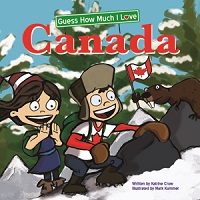| ________________
CM . . . . Volume XXIV Number 6. . . . October 13, 2017
excerpt:
Two cartoon children, a girl and a boy (siblings?) appear on the cover of Guess How Much I Love Canada, along with a beaver. The two children function as the book’s narrators while the purpose of the beaver, who is identified on the title page as Barry Beaver and “the national animal of Canada”, is to provide “all kinds of fun facts about the country of Canada.” On each double-page spread, the girl asks the same question of the boy [see excerpt], each time holding her hands a bit further apart, until, by the final page pairing, they are spread wide apart. In every case, except the book’s conclusion, the boy answers in the negative, adding “I love Canada more than that, because it has...” before listing the many things to see or do in that particular province or territory. Structurally, the book moves, by province, from west to east, with an interruption after Saskatchewan to head north to the three territories which are given short shrift by having all of them treated in a single spread. After returning to Manitoba, the contents continue eastward, concluding in Newfoundland and Labrador. On each spread, from two to four Kummer illustrated and captioned “photos” accompany Crow’s text. Sometimes, but not always, these “photos’ are places mentioned in the text. For example, to visually portray the Manitoba entry, Kummer illustrated the Canadian Museum of Human Rights, the Royal Canadian Mint and the sign for the Narcisse Snake Dens, but Crow’s text just referenced Narcisse. The captions beneath the illustrations are generally brief, with, for instance, that of the Royal Canadian Mint informing readers that the mint “can produce twenty million coins a day.” And Barry Beaver’s fun fact about Manitoba? “Some polar bears in Churchill have been known to be a bit feisty, so residents leave their cars unlocked to give people a safe place to escape from an angry polar bear.” Note that all of the words that appear in upper case in the text [see excerpt] are in printed in a variety of colours, including pink, green, blue, red, yellow and purple. Though young readers may not be immediately aware, on each province/territory spread, Kummer illustrates the children doing something connected to the text for that province. For Quebec, he has the children reclining on a bed of ice (Hôtel de Glace) while, for Prince Edward Island, he pictures them on a tandem bicycle (Confederation Trail). Most of Kummer’s “photos”, without their captions, are reproduced on the book’s endpapers. While the boy finally responds to the girl’s now fully outstretched arms question in the affirmative, with an emphatic “YES!” (in large red font), his supporting reasons for his response are not terribly convincing:
Neither “awesome” or “cool” is a very descriptive or evocative term while “might” is a weasel word that many parents include when responding to children’s “asks”, such as “Can we get a dog?” The challenge with Canada is identifying its audience. The picturebook format is “young”, but a lot of the content is “old”. How excited would an early schooler be to visit Quebec City’s Château Frontenac (“considered the world’s most photographed hotel”) or Victoria’s Fairmont Empress (that “serves over 500,000 cups of tea each year)? On the other hand, the possibility of walking on the Glacier Skywalk, near Jasper “that has a glass floor walkway that is about 288 metres above the ground” or going to Toronto’s Wonderland which “is home to one of the tallest and fastest roller coasters in the world, Leviathon” would be appealing activities for some. Sometimes, Barry Beaver forgets that his purpose was to provide “fun facts”, and, instead, he turns into The Big Bang Theory’s Sheldon Cooper. I can hear Sheldon’s voice intoning these “fun” facts:
or
Missing from the work is a map of Canada or a series of provincial/territorial maps indicating where the places named in the text are located. Reading that my neighbouring province had Canada’s longest pedestrian bridge, the Skytrail Bridge (910 meters), I was intrigued, but I had to go to Google to learn that this once railway bridge is in Outlook (and, unfortunately, has been closed to the public since 2013). Recommended with Reservations. Dave Jenkinson, CM’s editor, lives in Winnipeg, MB.
Next Review |
Table of Contents for This Issue
- October 13, 2017. |
